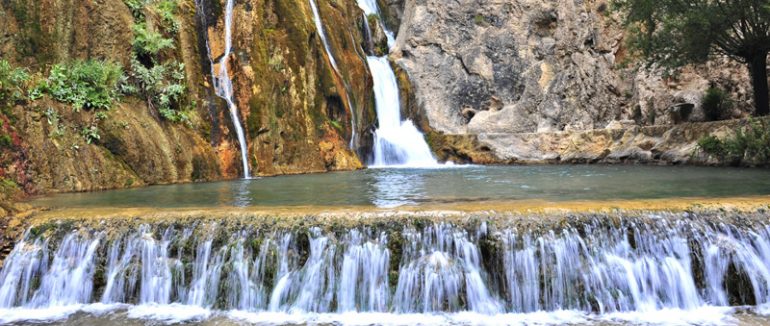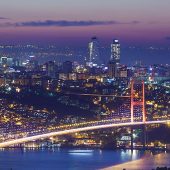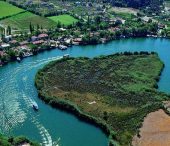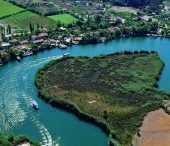Malatya is the capital city of the Malatya Province in the Eastern Anatolia region of Turkey.
Overview
In ancient times, it was also known by its older name of Melitene, that dates back to the Roman period. An even older name (of the ancient Hittite city) was Melid. Ancient Malatya lies a few kilometres from the modern city in what is now the village of Arslantepe and near the dependant district center of Battalgazi (Byzantine to Ottoman). The town of Battalgazi was the location of the Malatya city until the 19th century, when a gradual move to the present third location was started. Battalgazi's official name was Eskimalatya (Old Malatya) until recently, a name that is still used locally.
Malatya is located in southeastern Turkey, located at the foot of the Anti-Taurus Mountains. It lies at an altitude of 964 meters above the sea level and has hot, dry summers and cold, snowy winters. However, the constructions of several dams have made the climate milder.
This region of Malatya is best known for its apricot orchards. About 50% of fresh apricot production and 95% of dried apricot production in Turkey, the world's leading apricot producer, is provided from Malatya and the name of the fruit is synonymous with the city. After having been brought from its homeland in Turkestan in Central Asia and Western China, it reached its most delicious and sophisticated form in the fertile soil of Malatya, nourished from the alluvial soil of tributaries of the Euphrates. Overall, about 10-15% of the worldwide crop of fresh apricots, and about 65-80% of the worldwide production of dried apricots belong to Malatya. Malatya apricots are often sun-dried by family-run orchards following traditional methods, and collected and shipped throughout the world.
By its relative advance in industrial growth, Malatya is also a pole of attraction for its surrounding regions, in commercial as well as inward immigration terms. The city is at a key junction in Turkey’s road and rail network. By rail, it also serves as the junction for Aleppo through Syria - Samsun line. The bus terminal is located 5 kilometers west of the city center and there are regular intercity services to and from Ankara, Istanbul and Gaziantep. The railway station lies at a distance of 3 kilometers west of the city center and daily express trains run to Elazığ, Diyarbakır, Istanbul and Ankara. Both these stations are easily reached by taxis and dolmuş services.
Malatya's airport, Erhaç Airport, is 26 kilometers west of the city center and there are daily domestic flights from Istanbul, Ankara and Izmir. Also since year 2007, there are international flights appearing mainly on summer months. These international flights are especially from German cities to Malatya, mostly for transporting Turkish citizens that once immigrated to Germany for work.
Malatya is also the home of İnönü University.
History
Arslantepe, ancient Malatya
Main article: Arslantepe
Arslantepe is a site inhabited since the development of agriculture in the fertile crescent. It was called Maladiya, Melid or Meliddu by the ancient people. From the Bronze Age the site became an administrative center of a larger region in the kingdom of Isuwa. The city was heavily fortified, probably due to the Hittite menace from the west. The Hittites conquered the city in the fourteenth century BC. After the end of the Hittite empire the city became the center of the Neo-Hittite state of Kammanu. A palace was built and monumental stone sculptures of lions and the ruler erected.
The encounter with the Assyrian king of Tiglath-Pileser I (1115-1077 BC) resulted in the kingdom of Malatya being forced to pay tribute to Assyria. Malatya continued to prosper however until the Assyrian king Sargon II (722-705 BC) sacked the city in 712 BC. At the same time the Cimmerians and Scythians invaded Anatolia and the city declined.
Under Roman rule, Melitene was the base camp of Legio XII Fulminata
The city is located 670 km (416 mi) east of Ankara, and the two small towns outside the city constitute the most important sites for visiting. Aslantepe, at a distance of 7 km (4 mi), was once the capital of a Hittite state and dates back to the first millennium BC. It is the city carrying the old Hittite traditions and styles, and inside the city walls a palace has been found, with statues and reliefs, which are examples of the artistic works of that age.
Arslantepe was first excavated by the French archaeologist Louis Delaporte in the 1930s. Since 1961 an Italian team of archaeologists, today led by Marcella Frangipane, are working at the site.
Middle Ages
Part of the Eastern Roman Empire after the split of the Roman Empire, the city was captured by the Rashidun Caliphate in 638 became a base for their raids further into Anatolia, which was pursued also by the Abbasids. Byzantine Empire took the city back in 856 and it was violently disputed for a century between the Greeks and the Arabs.
In the 10th Century the Emperor Nicephoras Phocas convinced the Jacobite Patriarch of Antioch to moved many of his followers into the region of Melitene. These Syrians set up bishoprics in Melitene as well as in many surrounding cities.
In the period that followed the Turkish advance into Anatolia after the Battle of Malazgirt (Battle of Manzikert), Gabriel of Melitene, a Greek Orthodox Armenian (see Hayhurum) who had risen from the ranks of the Byzantine army, governed the city. From 1086 to 1100 he preserved his independence with the aid of the Beylik of Danishmends and after 1100, he invested heavily on the commanders of the First Crusade, especially Bohemond I of Antioch and Baldwin of Boulogne
Danishmends took over Malatya three years later in 1103 (see Battle of Melitene). With the Anatolian Seljuk Sultanate based in Konya taking over the Beylik of Danishmend in late 12th century, Malatya became part of their realm. The city became Ottoman in 1515.
According to the 1913 Catholic Encyclopedia, Malatya city was inhabited by 30,000 people at the time, with a clear Turkish majority, and an Armenian population of 3,000, of whom 800 were Catholics
Cuisine
Meatballs (köfte) have a special place in the cuisine as do apricots, which are used in many meals from kebabs (meat broiled or roasted in small pieces) to desserts. There are over seventy kinds of köfte (meatballs) usually made with wheat and other ingredients mixed in. "Kagit Kebabi" is one of the most important local specialities. "Kagit Kebabi" is a dish made of lamb and vegetables broiled in a wrapper, which is usually oily paper.
Festivals
Malatya Fair and Apricot Festivities has been held since 1978, every year in July, to promote Malatya and apricots and to convene the producers to meet one another. During the festivities, various sports activities, concerts and apricot contests are organized.
Near Apricot Festivities, there are also some other annual activities on summer. Cherry Festivities at Yeşilyurt District of Malatya and Grape Festivities at Arapgir District are organized annually.










